The appearance of acne in the oral cavity may indicate various pathologies. Formations in the palate often indicate dental problems, infectious diseases and other disorders.
To cope with the disease, you must consult a doctor in a timely manner. The specialist will conduct a comprehensive diagnosis and make the correct diagnosis.
Reasons for appearance
A pimple on the roof of the mouth can be the result of various abnormalities. For effective therapy, an accurate diagnosis must be made.
Dental diseases
The main cause of rash in the mouth is dental pathology. These include violation of hygiene rules, traumatic injuries, improper installation of prostheses and other factors.
With inflammatory damage to the tooth root, small pimples form. It may have a white or yellowish tint. As a rule, rashes on the palate are called stomatitis or inflammatory lesions of the mucous membranes.
Infections
Infectious pathologies also quite often cause rashes in the mouth. Most often this is observed in childhood. Cough, sore throat, and viral infections often provoke minor rashes.
Such pathologies are often accompanied by general weakness and increased body temperature. Subsequently, a white coating appears in the throat. This poses an even greater health hazard.
The child has
The cause of rashes in children is usually infectious diseases and other factors.
Common causes of acne on the palate include the following:
- Measles. In this situation, the rash appears as white-green papules. The rash disappears on its own after 2-3 days and does not require specific therapy.
In this case, the underlying disease must be treated. Otherwise there is a risk of dangerous consequences.
- Chickenpox. With this disease, rashes do not always affect the mucous membranes. However, sometimes this happens.
- Thrush. In this case, a white pimple with plaque appears. Sometimes it bleeds. The pathology does not pose a great danger, but can interfere with normal food intake.
- Dysbacteriosis. The disease often occurs in young children and is accompanied by the appearance of bloody pimples in the mouth. Pathology indicates disturbances in the composition of the intestinal microflora.
In an adult
The appearance of problems in adulthood may be due to the following factors:
- Herpetic infection. In this case, a transparent pimple filled with liquid may appear on the roof of your mouth. An exacerbation of the disease occurs against the background of a weakened immune system.
The disease does not require special therapy. However, it is important to avoid damaging the rash. Otherwise, this may cause the infection to spread.
- Glossitis. The cause of red bloody acne can be poor diet, drinking large amounts of alcohol, or allergies. In this case, small painful pimples form.
If treatment is not started in time, a crust will form on their surface. In such a situation, the doctor selects therapy.
- Syphilis. White pimples on the palate, which are not accompanied by pain, may appear due to infection with syphilis. The rash is varied in nature and affects different parts of the oral cavity.
- Inflammation of the tooth root. The appearance of white and yellow pimples can cause inflammatory damage to the tooth root.
In pregnant women
The main cause of problems during pregnancy is stomatitis. Its appearance is caused by an imbalance of hormones in the body. As a result, the immune system is weakened, and the mucous membranes lose their ability to cope with infection.
If this problem occurs during pregnancy, therapy should be started immediately. It should be selected by a doctor. The infection cannot be ignored as it can cause complications.
Varieties
There are quite a few types of acne on the palate. Each of them is characterized by certain features.
Red
Such pimples usually affect the throat area and may indicate stomatitis, allergic reactions, or scarlet fever. The rash can also be a symptom of lupus erythematosus.
How to remove acne spots? More details here.
White
Such formations affect the mucous membranes of the oral cavity in infectious pathologies. These include the chronic form of tonsillitis, candidiasis, viral or bacterial stomatitis.
Solid
An internal pimple with a hard consistency often accompanies angioma. This dental disorder can have several types and is a benign tumor lesion of a blood vessel. It is associated with the expansion and appearance of new blood vessels.
The formation is called a true angioma and is accompanied by the appearance of a compaction on the palate. In addition, angioma is isolated that affects the lymph nodes. However, this form of the disease is observed much less frequently.
How to treat a pimple on the roof of your mouth
To deal with acne, you need to determine the exact causes of its appearance. Depending on this, you can select medications and folk remedies.
Pharmacy products
Treatment is selected depending on the causes of the rash. Most often, doctors prescribe antibacterial agents and drugs that help relieve inflammation. For severe pain, analgesics are prescribed.
To cope with the pathology, you need to strictly adhere to the doctor’s recommendations and not interrupt the course of therapy at the first symptoms of improvement.
To eliminate the symptoms of fungal stomatitis, antifungal agents are indicated - in particular, fluconazole. Antifungal gels can also be used.
Rinsing the mouth with antiseptic solutions helps to cope with acne on the palate. If allergies occur, you need to stop contact with allergens and take antihistamines.
Often, in addition to the main medications, general strengthening agents are prescribed. They help improve immunity and make it easier to fight pathology.
ethnoscience
Folk remedies can only be used in addition to main therapy. There are many diseases that cannot be treated with home remedies. Syphilis is one of these diseases. Therefore, this treatment can be used after consulting a doctor.
To cope with inflammation and itching, you can use a soda solution. To do this, mix 250 ml of warm water with half a small spoon of soda, mix thoroughly and use for rinsing several times a day.
Kalanchoe and aloe have a similar effect. The juice of these plants must be used to treat the affected areas of the oral cavity.
The following infusions are highly effective:
- Take 1 large spoon of oak bark, mix with 250 ml of boiling water, cool. Rinse your mouth with the strained product 4-5 times a day.
- Take 1 tablespoon each of calendula, chamomile and yarrow, add 250 ml of boiling water and leave for 20 minutes. Rinse your mouth with the strained mixture 3-4 times a day.
To prevent the proliferation of pathogenic bacteria in the oral cavity, it is worth using a solution of hydrogen peroxide with a concentration of 3%. To do this, 1 large spoon of the medicine should be mixed with a glass of water and used to rinse the mouth.
To combat bacteria, tea tree oil is perfect. To do this, it is recommended to add 3-5 drops of oil to a glass of water and keep the solution in your mouth for 1 minute. It is recommended to carry out the procedure up to 5 times a day.
At home
To alleviate your condition on your own, you need to follow these recommendations:
- maintain cleanliness of the oral cavity;
- do not injure acne;
- Avoid citrus fruits, spicy and salty foods - this will help avoid irritation of the affected areas;
- exclude sweets - this will help avoid creating an environment favorable for the development of pathogenic bacteria;
- eat more protein foods - fish, cheese, meat;
- drink a lot of clean water;
- Avoid drinking hot food and drinks.
Video: How to treat sores in the mouth?
Prevention
To avoid the appearance of rashes on the palate, you should follow these recommendations:
- adhere to the rules of oral hygiene;
- treat dental diseases in a timely manner;
- strengthen immunity;
- lead a healthy lifestyle;
- Healthy food;
- Avoid too hot and spicy foods.
Photo: Nature of the rashes
How to remove acne scars on the face? Find out further.
How to remove acne marks on the face? The answer is here.
White pimples in the mouth indicate a malfunction of the immune system, the presence of a dangerous disease, or neglect of the rules of intimate hygiene. The microflora of the oral mucosa instantly responds to the action of pathogenic microorganisms, viruses and bacteria that provoke inflammation of the nasopharynx.
After diagnosing acne in the oral cavity, it is necessary identify the cause their appearance and only after that prescribe complex treatment.
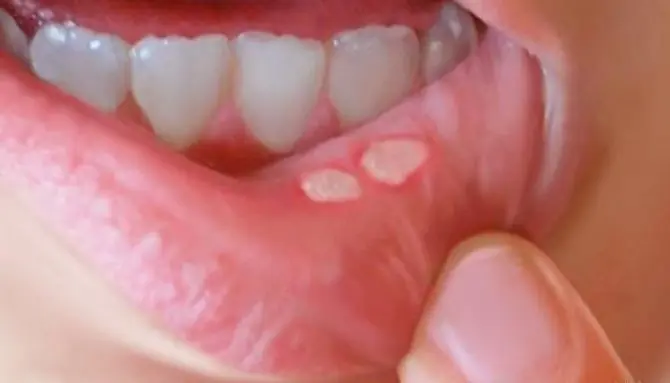
Causes of acne in the mouth
Pimples initially appear in the form of red spots. They cause unpleasant sensations in the form of burning, itching and pain when eating. In exceptional cases, the symptomatic picture is complicated by fever, chills and dry mouth. Pimples in the mouth can appear for the following reasons:
- Weakening of immune defense due to a viral or infectious disease, lack of vitamin and mineral microelements, sudden climate change, colds.
- Allergic reaction to chemical and organic irritants - food, pollen, animal hair. In this case, small pimples appear on the palate and in the mouth, causing itching and a slight burning sensation.
- Mechanical damage to the tongue and mucous membrane (scratches, bites, punctures, photo exposure when lightening teeth, etc.). The site of deformation begins to swell, a convex tubercle appears, which may be covered with a watery film.
- Infectious and fungal pathogens that localize and multiply in the area of a pimple in the mouth or on the cheek. The infection may spread further, causing a whitish coating to appear on the lips and gums.
- Failure to comply with personal hygiene rules, accompanied by untimely rinsing of the mouth, brushing teeth and tongue. The rashes are chaotic. White lesions may appear on the cheeks, gums, and side of the tongue.
An otolaryngologist will help determine the nature and cause of acne in the mouth and lip. He will conduct a visual diagnosis, prescribe comprehensive tests, and based on the results, he will prescribe a course of treatment.
Children's infectious diseases - diagnosis and specifics
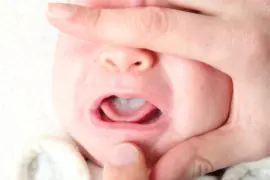
Thrush in a child's mouth
Small pimples in a child’s mouth are indicators of the presence of a disease that may be hidden. The exception is newborn babies who are breastfed. They may experience minor redness in the oral cavity for up to a year, which is covered with a white coating. This disease is called - thrush, and is caused by the spread of fungal colonies of the Candida type. Pediatricians advise wiping white pimples in a child’s mouth with a soda solution. If colonies of microorganisms spread (you can see the photo) after stopping breast milk, you should consult a doctor to get a prescription for drug treatment with antifungal drugs.
Pimples on the inside of a child's cheek may be covered with a whitish coating or have a swollen surface. They may indicate the development of infectious diseases such as:
- lupus erythematosus;
- chicken pox;
- scarlet fever;
- mumps;
- whooping cough or measles.
The incubation period of each disease is 3 days. At this time, transparent pimples in the mouth, a sore throat, an increase in the size of the tonsils, an increase in body temperature and microscopic cracks on the lips, accompanied by a slight discharge of blood, may appear. Sensitivity of the front teeth and gums is noted.
Diseases are infectious in nature, and the appearance of acne is considered as an isolated symptom indicating negative processes in the body. Therefore, there is no point in trying to treat tumors. Treatment is prescribed by a pediatric infectious disease doctor, writing a prescription for antibiotics, anti-inflammatory and antipyretic drugs.
Watery pimples - clinical picture
Pimples in the mouth appear quite rarely in adults. They are indicators of the presence of a hidden disease inside the body, which can be chronic. Initially, tiny ulcers appear on the palate or inside of the cheek, characterized by the presence of an internal depression in the soft tissue. Over time, they develop into raised pimples on the lining of the mouth, which can spread to the throat and along the gums, causing bleeding. Their appearance may be a sign of:
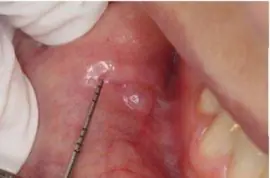
- venereal disease (a symptom of syphilis, ureaplasmosis or HIV infection);
- herpes localized in the oral mucosa (exacerbation of the disease is observed in the autumn-spring period);
- bacterial stomatitis, affecting the soft tissues of the nasopharynx (pimples resemble ulcers that cause pain when eating, drinking, spitting);
- candidal stomatitis, characterized by pimples in the mouth of an adult, covered with a dense layer of white plaque (develops against the background of a weakening of the immune and regenerative functions of the body).
Purulent white pimples in the mouth can be indicators of diseases of the circulatory system and infection, the source of which is in the intestines. Dysbacteriosis provokes a disruption of the microflora in the oral cavity, causing an inflammatory process inside the soft tissues.
To treat a pimple on the roof of your mouth, you need to see a doctor and start strengthening your immune system by taking vitamins and normalizing the caloric content of your daily diet.
Primary care for acne on the cheeks, gums and tongue
If a watery pimple appears in the mouth, or an ulcer covered with a white film, you should immediately review the menu. During the period of exacerbation of inflammation of the mucous membranes, citrus fruits, sweet and sour fruits and concentrated juices containing amino acids are excluded from the list of products.
Some vegetables should be heat treated to keep the food soft.
Rusks, chips, tough meat, fresh pears and apples can damage the watery layer of the ulcer and cause the rash to spread.
Treatment methods
An independent course of treatment should not be prescribed. Many people look at the photo and begin to rinse their mouths with decoctions, tinctures and traditional medicine. Only an experienced doctor can accurately diagnose a white pimple in the mouth and determine the cause of its appearance.
If the palate, cheeks and tongue are covered with a transparent coating with a white tint, rinsing is initially prescribed:
- a decoction of oak bark, celandine, yarrow, nettle and birch;
- chlorophyllipt solution;
- boiled water with the addition of oil essence of sea buckthorn berries.
If a pimple in the mouth on the cheek causes unbearable pain or frequent itching, a specialist may prescribe an analgesic drug. It should be taken according to a prescription, taking into account precautions and existing contraindications. Treatment for neoplasms on the mucous membrane should be comprehensive. Doctors use:
- medications;
- antimicrobial and antifungal ointments;
- lotions that soothe inflammation;
- immune therapy aimed at strengthening the body's protective functions.
The use of toothpastes and personal hygiene products containing alcohol and lauryl sulfate in the combined composition is temporarily excluded. The molecules of these substances deform the transparent layer of the ulcers, causing them to increase in size up to three times.
Prevention of oral diseases
Adults and children must follow basic rules of personal hygiene in order to avoid the need to treat the disease that has arisen. Every day in the morning and evening you should:
- brush your teeth using antibacterial agents, eliminating the likelihood of bleeding gums and the formation of caries (whitening pastes can be used no more than once every six months);
- use dental floss treated with an antimicrobial solution;
- rinse your mouth with a solution of soda or herbal tincture of chamomile, which helps normalize the acid-base balance and heal microscopic wounds.
Once every three months, it is recommended to visit a dentist who can treat teeth at an early stage of damage. Caries is the first symptom of a disease inside the oral cavity, which can provoke the proliferation of pathogenic microorganisms and fungal colonies.
You should also review your daily diet. People with chronic gastrointestinal disorders and diabetes have an increased risk of developing painful ulcers and lesions on the tongue, cheeks and palate.
Nutritionists advise excluding “fast” carbohydrates, sugars and carbonated drinks from the menu. They disrupt metabolism, slow down the metabolic rate and provoke the appearance of ulcers.
Hands should be washed thoroughly before each meal. This applies to vegetables, berries and fruits. Their peel may contain microbes, bacteria and worm eggs, which are washed off under running cold water.
These simple rules will help prevent problems associated with inflammation of the mucous membranes and the development of infectious diseases.
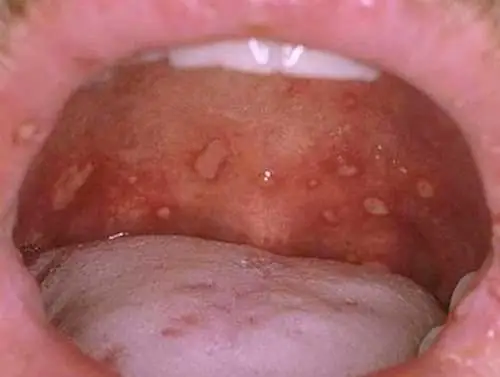
Acne outbreaks are a widespread problem that we all face at one time or another and try to get rid of them as quickly as possible. Most people are quite used to the appearance of pimples and acne on the chest, neck, face, shoulder and upper back. But the appearance of a pimple on The palate of the mouth is a cause of concern for most patients who come to the doctor with such a problem in themselves or their children.
If you have not previously experienced pimples in the mouth, it may seem strange to you to know that a pimple can appear in the mouth, especially on the hard upper palate and its part. Pimples on the roof of the mouth resemble regular acne, which also appears on the face.
At first, such inflammation begins as a minute bump that appears on the roof of the mouth and grows larger and larger over the next one or two days.
It is usually filled with pus, and if you press on a pimple on the roof of your mouth, it will burst just like a normal one.
The causes of acne on the roof of the mouth and body are very similar. They appear when the pores in this area become infected and clogged with a large amount of pus.
Mouth pimples are not that common, but you may be affected by the problem, especially if your body produces excess oils. Those who are vulnerable to frequent skin acne often notice pimples appearing on the roof of their mouth when they have the flu or fever. In addition to such inflammation, acne of this form can appear on any areas and parts of the body, including the inner walls of the nose or ear.
Causes of red pimples on the palate in children and adults
Clogged pores
Like any other type of acne, acne on the roof of the mouth is caused by clogged and infected pores that collect under the skin, become inflamed and irritated. Although the mouth is not the most common place for acne to form, some people with excess sebum oil suffer from this type of acne.
Irritation caused by food
Pimples on the roof of your mouth can be caused by irritation after eating something too hot or spicy. Pimples on the inside of your mouth can also be caused by a burning sensation caused by eating overly spicy, salty or sour foods. So make sure that the temperature of your food is normal and that the regular food you eat you consume does not cause irritation in the form of a pimple after some time. Especially in a child, hot food can cause pimples on the upper palate of the mouth.
White and red pimples on the roof of the mouth are still not a permanent form of acne; if they appear again and again, then they can be symptoms of even more severe diseases such as oral cancer or symptoms of herpes.
Oral cancer and acne on the roof of the mouth
Pimples on the roof of the mouth that appear repeatedly or do not go away can be a warning sign of oral cancer, which involves uncontrolled, malignant growth and proliferation of cells in the mouth.
Oral cancer can be fatal if not diagnosed and treated promptly It is characterized by dark, asymmetrical masses scattered in different areas of the mouth Many begin on the tongue and lips before materializing in other areas and may metastasize elsewhere, most likely , through the lymph nodes.
Symptoms of oral cancer include:
- Repeated persistent pimples or bumps;
- spots;
- Soreness;
- Swelling in the mouth;
- Lesions in the mouth;
- White or red blotchy spots in the mouth;
- Oral bleeding;
- Discomfort in the throat;
- Dysphagia;
- Hoarseness of voice;
- Unusual weight loss
If you notice these symptoms accompanying a pimple on the roof of your mouth, contact your oncologist immediately.
Risk factors for oral cancer:
- Smoking;
- Chewing tobacco;
- Binge;
- Family history of cancer;
- Excessive exposure to UV radiation and HPV infection;
- Men are at greater risk of developing oral cancer than women.
The mortality rate associated with oral cancer is very high. This is not because it is difficult to detect or diagnose, but because it is often not diagnosed until it is too late. If you find recurring pimples in your mouth, visit your doctor as soon as possible .
Pimples on the palate of a child's mouth
Pimples on the roof of the mouth in a baby or preschool child can also be caused by Epstein's pearly disease, which are common, benign, painless cysts that affect about 80% of babies. Also known as palatal or gingival cysts, these pimples are white or yellowish bumps found more commonly all over the roof of the mouth They can be mistakenly perceived as growing teeth, however, you can also understand that these are pimples when wearing glasses.
Epstein pearls form in the uterus when the mucous membranes become trapped during palatal formation.
These oral pimples do not require any treatment because they are harmless, painless, and usually disappear within a few weeks. If Epstein's pearls are still present after a few weeks, discuss their treatment with your doctor.
Stomatitis
These are bumps (canker sores) that appear on the roof of the mouth, the base of the gums, and the inside of the cheeks and lips. The root cause of these pimples is unknown, but they are thought to be caused by allergies, hormonal imbalances, menstrual periods, poor diet, and stress. Trauma to oral tissues. ulcers, such as recent dental work or cheek biting, can also lead to ulcers, particularly in a child.
If there is pain or great discomfort, ask your doctor to drain the injury using a sterile needle.
Herpes
Cold sores (fever) are a group of small pimples in and around the mouth, including the roof of the mouth areas. The area around these bumps is often red, swollen and tender. They are caused by the herpes simplex virus. Herpes is highly contagious and easily spread from one person to another. Once they appear, these pimples break open , infectious fluid leaks out, scab They disappear on average after two weeks. They are accompanied by pyrexia or fever and swollen glands.
If the situation gets worse, see your doctor for treatment.
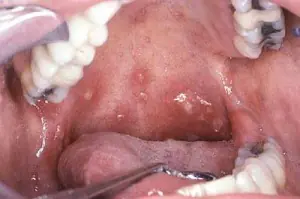
White pimples on the roof of the mouth photo
How to treat acne on the roof of the mouth in children and adults?
Treating acne in the mouth is much more difficult and dangerous than treating acne present on the face and body.
Since these outbreaks are in the mouth, you cannot use regular acne medicine such as blemish and pimple cream or toning lotion as these medications cannot be taken orally. If you are tempted to pop a pimple, it is highly recommended not to do so.
Nails can damage the skin and cause bacteria to form in pimples. Since the oral cavity is a source of bacteria, you can make things worse. Avoid constantly touching pimples, as the process of formation of inflammation will quickly worsen.
You can ease the discomfort and get rid of acne on the roof of your mouth faster by using a few simple home remedies:
Using salt water or baking soda
Use baking soda or salt water to get rid of pimples on the roof of your mouth.
How to use?
- Add a few teaspoons of salt to a glass of warm water. After rinsing your mouth, spit out the solution, repeat the procedure two or three times a day.
- An alternative to this is to make a baking soda solution. Mix one tablespoon of baking soda with a medium cup of warm water. Rinse your mouth with it and then spit it out.
Hydrogen peroxide solution
How to use?
Prepare a 3% hydrogen peroxide solution to clear away pimples on the roof of your mouth.
- Pour a small amount of hydrogen peroxide into a plastic cap and mix with an equal amount of water.
- Dip a cotton swab into the peroxide solution and apply it only to the inflamed pimple.
- Twist the cotton swab and repeat the procedure.
Be careful not to swallow any of the hydrogen peroxide drops if possible.
Hydrogen peroxide is an antibacterial agent that reduces the number of bacteria present in the mouth and helps treat acne. The ulcer should go away in about three to four days if you do it twice a day.
Essential oils as a remedy for acne on the roof of the mouth
Home spray recipe:
Eucalyptus and peppermint essential oils have anti-inflammatory properties and also act as antimicrobial astringents to help tighten the tissue around the pimple, relieving further discomfort caused by tenderness or potential bacterial buildup. The soothing properties of both of these oils can also soothe an irritated and inflamed oral area .
What you need?
To make a spray with these two oils, you will need:
- Two tablespoons olive or grape seed oil
- Peppermint essential oil: ten drops
- Eucalyptus essential oil: eight drops
- Glass bottle
What do you need to do?
Pour olive or grape seed oil into a bottle and stir in the essential oils. Close the bottle, shake it well and apply with a cotton swab directly to the pimple sore if needed for relief. Shake before use each time.
Mouth rinse for acne on the palate
You have two options for mouth rinse:
- Dexamethasone, which is a steroid mouth rinse that reduces pain and inflammation Dexamethasone reduces the number of relapses, but this treatment option is usually reserved for more severe cases.
- Tetracycline is an antibiotic used for more extreme cases. Your pimples will heal quickly, but your mouth will be vulnerable to a fungal infection called thrush Thrush is a fungal infection caused by yeast in the lining of the roof of your mouth.
Surgical treatments for acne on the roof of the mouth for cancer may include
- Removing a tumor surgically Your doctor may cut away the tumor and clear away the area of healthy tissue that surrounds it Tumor removal can be done with minor surgery Larger tumors may require more extensive surgical procedures For example, to remove a large tumor, the surgeon may also remove part of the jawbone or even part of your tongue.
- Surgery to remove cancer that has spread to the neck If cancer cells have spread to the lymph nodes in your neck, your oncologist may recommend a procedure to remove the affected lymph nodes and surrounding tissue in the neck (neck dissection).
- Surgery to Rebuild Your Mouth After surgically removing a tumor, your surgeon may recommend reconstructive surgery to restore the appearance of your face or to help you regain your ability to speak and eat. Your doctor will transplant skin, muscle tissue, or bone grafts from other parts of your body to restore your face. Implants are used to replace natural teeth.
- Surgery carries high risks of infection and bleeding. Surgery for oral cancer often affects the patient's ability to eat, speak, and swallow.
Radiation therapy
Radiation therapy involves the use of high-energy beams such as X-rays to kill cancer cells. Radiation therapy can be administered from a machine outside the patient's body (external beam radiation) or from radioactive seeds and wires placed near the affected area (brachytherapy).
Treating oral cancer with radiation therapy may be the only course of treatment recommended if your tumor is found at a very early stage. Radiation therapy can also be used after surgery. In some cases, it is combined with chemotherapy. This combination increases the effectiveness of radiation therapy, but also increases the risk of adverse effects. that you may have For patients with advanced oral cancer, radiation therapy may help treat symptoms caused by the cancer.
Unpleasant side effects of radiation therapy on your mouth may include tooth decay, dry mouth, mouth ulcers, bleeding and stiff jaws, fatigue and redness.
Precautions when treating acne on the palate in adults and children
- Brush your teeth as gently as possible Maintain oral hygiene daily, also use dental floss and rinses.
- Avoid Stress and Relaxation Acne flare-ups are widely associated with stress during times of intense emotional depression. Acne on the roof of the mouth can be aggravated by stressors.
- Pay attention to your diet and avoid fatty, oily foods.
- Avoid spicy or hot foods, which can further irritate acne Peppers and carbonated drinks should be avoided Fruits and vegetables such as oranges, pineapples, lemons, apples, tomatoes and strawberries can also cause acne.
- Increase your intake of vitamin B12, zinc, iron and folic acid If you need to take vitamin supplements, you should first consult your doctor or nutritionist.
- Try not to irritate the inside of your mouth. Avoid smoking and using tobacco.
Frequently asked questions about pimples on the roof of the mouth
When should you see a doctor?
Pimples like this on the roof of your mouth most often disappear without any treatment within a week. Sometimes you may have a persistent pimple on the roof of your mouth as it comes back again and again after some time to disappear. If the pimple does not disappear after three or four weeks of use home remedies or appears again and again, consult your doctor immediately because it may be an indicator of some serious diseases such as oral cancer. If the spot is associated with any diagnosed disease, visit your doctor regularly to keep him updated about positive or negative changes in your condition.
How long does it take for treatment?
Usually, with regular treatment of acne on the roof of the mouth, inflammation disappears within two to three weeks after its appearance. Within a few weeks, pimples, which a person may confuse with a mucocele, ulcer or herpes, also disappear. Persistent acne requires clinical and medical attention.



